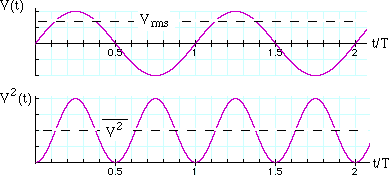Well this thread wouldn't exist if it were well understood. Using a term to mean something different from what it literally means is always going to result in confusion.
RMS voltage is not the same as average voltage. RMS power is not the same as average power.
Well this thread wouldn't exist if it were well understood. Using a term to mean something different from what it literally means is always going to result in confusion.
RMS voltage is not the same as average voltage. RMS power is not the same as average power.
"Average power" is the correct term, and "RMS power" is an incorrect term that should not be used.
Hello,
The way we use language can vary quite a bit, and our language is not a context free language. In a context free language you can parse a sentence without knowing who said it or more importantly what topic was being talked about at the time. Strictly speaking what this means is that we can NEVER be sure of how a phrase renders into meaning until we also know the body of discussion from which it came. And that brings us to that little part of language we call "rendering".
In a literal word by word translation every word is taken to be just what it is and it's meaning may be context free. But in rendering that translation into the meaning that would be only understood by the local people the meaning could very well change.
There are many examples, i'll give a few here...
"log cabin"
Does this mean that a cabin is made from one 'log' ?
Does this mean we are to take the mathematical 'log' of the variable 'cabin' ?
The literal translation would make anyone wonder.
What happened is that we see RMS voltage, RMS current, and then want to apply that same method of translation to the phrase "RMS Power" or "RMS Watts". The latter two terms were NOT established in the same manner as the first two, but following the way language works they are in fact valid. They might be called idioms, which means their meaning can not be deductible from the individual words, at least not in the same way as the first two are.
If we look at it closer, what "RMS voltage" means is the root of the mean of the square of the voltage, but what "RMS Power" means is that it is the power measured using RMS values for voltage and current. So it might be a little confusing and technically probably should not have been called that, but *WE* dont always get to choose what is right in language, it is the originators who decide and if it catches on, then it prevails over time. There's always the chance that it may be changed in the future, but it's so ingrained in the audio industry that there seems to be little chance of that happening.
Another example from your previous post...
In the context of which you speak there is no such thing as "RMS Power" (meaning the RMS value of the peak power waveform), so saying that it is a meaningless measurement is meaningless in itself because there is no such measurement to begin with, yet you had no problem quoting that it was a "meaningless measurement". That's how language works too, we sometimes take short cuts. We probably dont want to have to say, "RMS times RMS Power" which would be more correct mathematically for example, and it would sound funny to say, "logs cabin".
In your first post you quote that "RMS Power" is "wrong", but it's being used by the audio industry and has been used for a number of years now. It's only wrong if you want to try to force a particular usage of language, which is almost impossible even in technical literature.
Isaac Newton tried to invent a new language that was more logical, but it never caught on. Lucky he invented gravity though or we would all be floating in space right now




